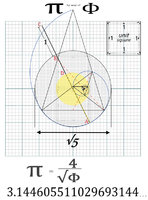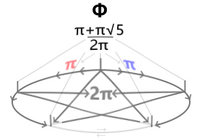nothing
New member
- Joined
- Dec 9, 2019
- Messages
- 46
Can π not be derived by way of a circle whose diameter is √5? For example:

AB is equivalent to the diameter of the outer circle, which is √5.
AC is thus (√5 + 1), wherein AD is AC/2 (highlighted) such to geometrically represent (1 + √5)/2.
If AC is rotated about the center of the √5 circle, point D draws a unit circle which "kisses" the unit square at four points.
I understand π is approximated to 3.14159... but does this not eliminate the need for any approximation? Why not 4/√Φ directly?
The reason I am asking is because if the above is true, from Φ's own root is derived π,
which is to my knowledge not a relationship presently recognized else
why would humanity have been using a mere approximation of π
instead of the actual whole integer 4 over the root of Φ?

AB is equivalent to the diameter of the outer circle, which is √5.
AC is thus (√5 + 1), wherein AD is AC/2 (highlighted) such to geometrically represent (1 + √5)/2.
If AC is rotated about the center of the √5 circle, point D draws a unit circle which "kisses" the unit square at four points.
I understand π is approximated to 3.14159... but does this not eliminate the need for any approximation? Why not 4/√Φ directly?
The reason I am asking is because if the above is true, from Φ's own root is derived π,
which is to my knowledge not a relationship presently recognized else
why would humanity have been using a mere approximation of π
instead of the actual whole integer 4 over the root of Φ?

